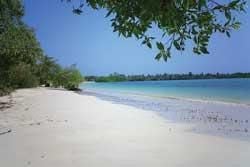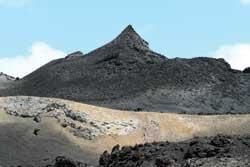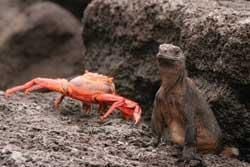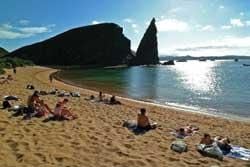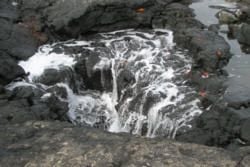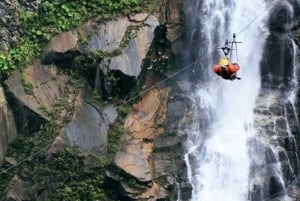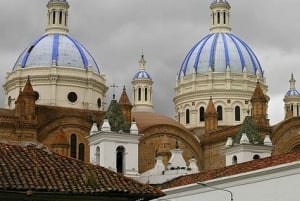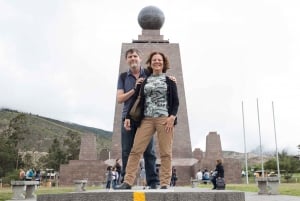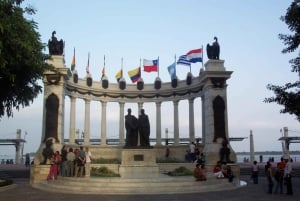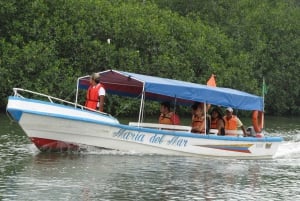The Galapagos Islands
The Galapagos Islands are perhaps the most intriguing place on earth.
Referred to as "The Enchanted Islands" in the colonial times because of a phenomenon that caused them to "disappear" from human sight, the name fits the Galapagos Islands perfectly, as they captivate every soul as soon as eyes are set on them. With their varied and fascinating geology, red, black, and white sand beaches, prehistoric looking iguanas, fearless as well as unique animals, magnificent marine life, a bird haven, these islands provide the ultimate nature experience, unlike any other place on earth.
The Galapagos Islands are located in the Pacific Ocean, at approximately 960 Km (600 nautical miles) from the Ecuadorian continental territory. They are altogether 61 islands and islets with 13 main islands of which 4 are inhabited: Santa Cruz (Indefatigable), San Cristóbal (Chatham), Isabela (Albermarle), and Floreana (Charles) (the Spanish names are the official ones; the English ones were given by the first cartographers of the area).
The Galapagos touristic operation is controlled by the government to safeguard the islands' and the marine reserve's natural wonders, and has been an example of conservation in the world. Very strict regulations have been established by the Galapagos National Park to minimize the impact of human visits on the archipelago’s ecosystems, e.g. visits on uninhabited islands must be done with the company of a nature guide (at least one for every 16 passengers) certified by the Park's authorities and are restricted to the areas delimited by the marked paths. Not all the islands and islets are open to visitors. Also, all vessels and land accommodation have to be granted a permit to operate and visit itineraries must be approved by the Park’s authorities.
Thanks to the conservation efforts, most of the species studied by Charles Darwin still exist on the islands, giving nature lovers the opportunity to observe closely some of the strangest -and most beautiful- creatures in the world in their natural habitat. Boobies, cormorants, pelicans, penguins, flamingos, frigate birds, and finches are just a few of the bird species seen in the area. But winged creatures are only a portion of the wildlife in Galapagos: marine life offers a vibrant combination of fish including giant rays, dolphins, sharks, eels, and even whales; reptiles, like the marine iguanas, and mammals, like the sea lions, have also their fair share on the islands. Wildlife watching opportunities are virtually unlimited and the animals are fearless: visitors can pass as close as centimeters from numerous species; in fact, one often has to circle around to avoid stepping on them.
The most popular way to visit the archipelago is on boat cruises . There are many authorized vessels, from small 16-passenger yachts to 100-passenger ships. Another way to visit the Galapagos is by combining a stay on one or more ("island hopping") of the four inhabited islands with organized visits to nearby islands and islets. The accommodation supply on the four islands is large, especially on Santa Cruz, which is also considered a "tourism hub" because it is where most of the cruises set sail. Nevertheless, the other three islands have developed an interesting touristic offer too, from most to least, San Cristobal, Isabela, and Floreana.
The best way to get to the Galapagos is by air via Quito or Guayaquil; three airlines, TAME, Aerogal, and LAN, offer flights daily to the airports of Baltra (across Santa Cruz Island) and San Cristobal, the only airports that can manage large aircrafts. There is no regular maritime service for passengers. Private yachts can arrive to the ports with special permits. One can travel between the inhabited islands on small planes or motor boats. The transportation terms and availability may change, so it is convenient to inquire if needed.
There isn’t a best or worst time to visit the Galapagos, it all depends on your personal preferences, in terms of weather and wildlife sighting opportunities. Please visit our Weather page for information on this subject. The high season is between June and August and end of December to mid-April.
The Galapagos Islands emerged as the result of violent volcanic action about five million years ago, a recent event in geological terms. Live organisms gradually arrived from the continental coasts by water and air and slowly adapted to their new environment thus evolving in a different manner than their relatives on the continent, many of them ultimately becoming unique species on the planet. This was what struck Charles Darwin when he stopped at the islands on his journey aboard the HMS Beagle in the 1830s; his observations of the Galapagos served as an important base for his theory of evolution described in his book "On the Origin of Species". Thinkers of the time confirmed their long time suspicion that species were not immutable and declared the archipelago the largest and best live laboratory of the world as well as "the" laboratory of evolution.
The first officially recorded human visit to the Galapagos was that of Tomas de Berlanga, a Spanish bishop who was sailing near the coasts of Central America in February 1535 and was pushed by the currents toward some mysterious islands; Berlanga wrote to Charles V, King of Spain, "Here birds are very dumb, they can't fly". The islands had been officially discovered. Having arrived to the islands less than 500 years ago, the human species is one of the most recent inhabitants.
The archipelago was named after the giant galapagos (saddle-back) tortoises. Its 61 islands and islets were declared a National Park in 1959, and also that year the Charles Darwin Station officially commenced activities. UNESCO declared them a Natural Heritage of Humanity in 1978. In 1998, the Ecuadorian government enacted the Galapagos Special Law, a legal framework to protect the islands and its surroundings, and created the Galapagos Marine Reserve.
The Islands and Visitor Sites
Santa Cruz (Indefatigable) Island is the most developed in terms of tourist infrastructure. It has many accommodation options and several tourist sites which can all be visited without a guide, and the islands’ main airport, Baltra, is nearby. Its main town and port, Puerto Ayora, is full of restaurants, bars, shops, and tourist agencies, and most of the Galapagos cruises start from here. Here you can stock up on supplies like photo equipment and batteries, medicine, food, and water. It also has a basic public hospital and a hyperbaric chamber. The Charles Darwin Research Station is in Puerto Ayora, where you can learn about the conservation efforts taking place in the islands and about the islands’ history, geology, and ecology. On the island’s grassy highlands you can see (at some times of the year) the famous galapagos giant tortoises in their natural habitat. There are several dive sites and dive shops; sharks are frequently seen at Gordon Rocks. Another interesting site on Santa Cruz are the Twin Craters("Los Gemelos"), two sinkhole craters which are also a good place for observing endemic plants and birds. Lava tubes can be hiked and explored. There are a number of white sand beaches like Tortuga Bay, a protected swimming and surfing area (on the way to Tortuga you can see the mangrove surrounded Las Ninfas lagoon), and La Playa de los Alemanes, from which a rocky trail will lead you to Las Grietas, two 40 ft (12 mt) high rock crevices filled with water. Las Bachas beach offers the chance to see sea turtle eggs laying on the sand.
San Cristobal Island is the second most visited. It is home to Puerto Baquerizo Moreno, the capital of the Galapagos province and where San Francisco University’s Galapagos campus is. It also has an airport, many different visitor sites, and a good tourist infrastructure with hotels, restaurants, and shops. Better known for surfing, but also with a few excellent snorkeling and scuba-diving sites, beautiful white sand beaches, wildlife observation, and the only freshwater lake in the Galapagos, this island is one of the most popular. La Loberia and Playa Ochoa are beautiful beaches with large sea lion populations and where it is possible to camp overnight with a permit from the National Park; La Loberia is easily accessible near the airport and a good surf spot; Playa Ochoa is better for snorkeling. Playa Mann is the best beach for relaxing, swimming, and snorkeling, right across the street from the University. Punta Pitt, Cerro Tijeretas, Galapaguera de Cerro Colorado (a giant tortoise breeding center) are other visitor sites for wildlife observation and magnificent views.
Isabela (Albemarle) Island, the largest of the archipelago, is a young island formed by five volcanoes which are still active. The biggest town on Isabela is Puerto Villamil, a small fishermen town with essential services. Most of the lodging options on the island are very basic, including some great camping areas, as well as the offering of restaurants and bars. In spite of its spectacular landscapes, its varied and abundant wildlife, including flightless cormorants and Galapagos penguins, and many visitor sites, Isabela is not a popular day visit, because the majority of the sites are on the west side, a long way by boat from Puerto Ayora. It is possible to reach the island by plane from Baltra, though. Some of the most interesting sites are: Humedales ("wetlands"), a trail through beaches, rocky shores, pools, and mangroves, with several interesting points and wildlife sighting opportunities along the way; Alcedo Volcano, with its huge crater and its various steam vents, and which is home to a colony of giant tortoises; Urbina Bay; Punta Moreno; and Sierra Negra Volcano.
The western island of Fernandina (Narborough) is the youngest of the main islands and has the highest volcanic activity. This island’s immense dome shape enchants visitors but, as one of the most remote (and pristine) islands, it is not included in most of the itineraries. Punta Espinosa has hikes through recently formed lava fields, with an abundance of resident wildlife, including marine iguanas, pelicans, sea lions, penguins, and flightless cormorants. The marine area around the island is often called a Whale Sanctuary because whales and dolphins feed here.
Floreana (Charles) is the island with the longest human history; in 1835, when Charles Darwin arrived to the archipelago, a 200 to 300 prisoner penal colony was there. It was also a popular stop for pirates and whalers, who got food and water there. Because of this early and long human presence, the island’s ecosystem has suffered greatly, with the extinction of species on the island like the giant tortoises, and the introduction of harmful foreign species. Nevertheless, near Point Cormorant beautiful pink flamingoes can be seen in a secluded lagoon and sea turtle nests on the beach (between December and May). Great snorkeling can be done at the Devil’s Crown. The famous 1934 "Galapagos Affair" occurred on Floreana.
Bartolome’s 115-mt (377-ft) Pinnacle Rock, the most famous location of the archipelago through photography, allows stunning views of two bays from its summit. This island is the most interesting geologically speaking and beautiful, with amazing lava formations and spatter cones. Visitors can get the opportunity to swim among penguins around Pinnacle Rock.
The northeastern island of Genovesa (Tower) is too remote to see on a day-trip, but it is worth to include in a cruise for its beautiful landscapes and views, and for its amazing and abundant avifauna that includes frigate birds, red-footed and masked boobies, lava gulls, Darwin’s finches, and many more.
Española (Hood) is the oldest island of the archipelago. It is known as the only nesting site of the Waved Albatross and it is home to the Christmas Iguana, a subspecies that turns red and green during mating season. Gardner Bay has a white coral sand beach for fine swimming and snorkeling.
Santiago (James) offers fantastic lava formations, a black sandy beach for great swimming and snorkeling, and Darwin’s toilet, a water spurting rock formation.
The small island of Rabida (Jervis), south of Santiago, marvels visitors with its contrasting colors, dark red sand beaches and rocks, turquoise waters, and lush green vegetation. It is also rich in some of the rarest bird species, nine varieties of finches being found here, as well as Galapagos hawks and brown pelicans. The waters off the island’s walls provide one of the best and easiest spots for deep-water snorkeling.
North Seymour Island, a small island north of Baltra (South Seymour), is a popular day-trip. There, blue-footed boobies and frigates can be seen courting, mating, nesting, or chick nesting very close to the trails at any time of the year. Snorkeling and diving are excellent, with chances to see white-tipped reef sharks, manta rays, eels, and many others.
Located between Baltra and North Seymour, Mosquera Islet is a tiny coral and rocks reef which is a popular dive site from Puerto Ayora.
South Plaza Island is a small island that changes colors with the seasons, is covered by Opuntia cacti, and is home to one of the largest sea lion colonies as well as colorful yellow and red land iguanas.



